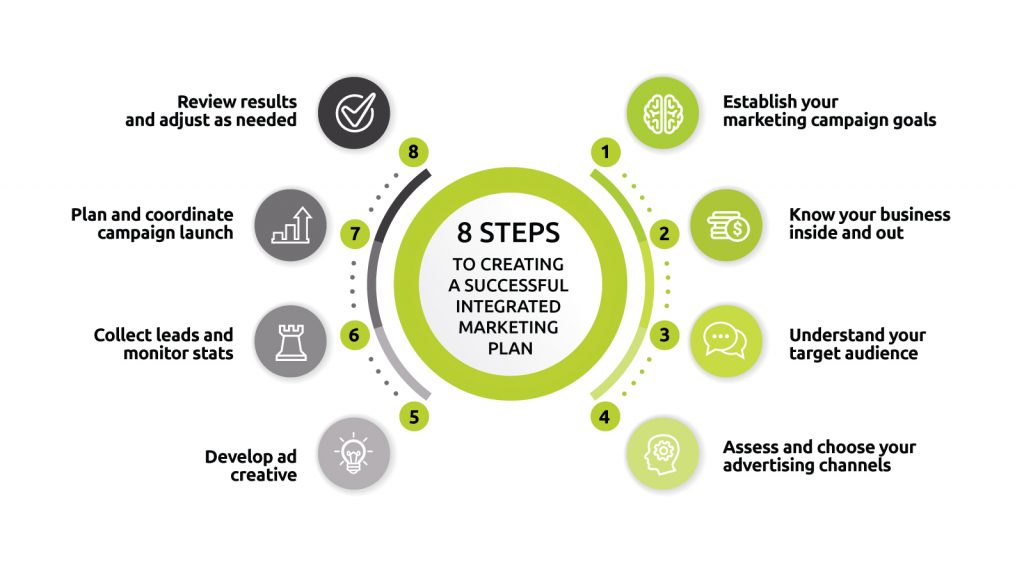How to Create a Successful Integrated Marketing Plan in 8 Easy Steps
In an age where so many businesses in various industries are competing to grow their leads and sales, one way to achieve this is to create a robust integrated marketing communication plan.
Integrated marketing communication campaigns are beneficials for businesses of all sizes, from enterprise organizations to new start-ups. These strategies help businesses create clear, concise campaigns that can reach the largest and most relevant target audience to help generate demand, raise brand awareness, and more. All of which will increase sales and profit margins.
What is integrated marketing communication (IMC)?
Integrated marketing communication is a strategy where you deliver a consistent unified message, such as a promotion or brand messaging, across every form of media necessary to reach your business goals. Business goals would include a reaching a larger audience, expanding into new territories, improved lead conversion, customer retention, and improving brand experience, in order to grow sales and profits.
Creating a cohesive and unified brand message that’s capable of being transmitted across multiple platforms isn’t easy. But thankfully, there are a few things you can keep in mind to make the task more manageable. “The planning stages when developing an integrated marketing communications strategy are crucial,” remarks Sandra Dugas, Partner and Marketing Director at London, Ontario’s ZOO Media Group. “Weeks of strategizing and market evaluations are needed prior to rolling out a successful marketing campaign.”
Why is integrated marketing important?
The fact that it takes consumers an average of 7 interactions with your brand before a purchase will take place, is why creating integrated marketing campaigns is so important for business owners and marketing professionals. The benefits of creating an IMC plan rather than individual channel campaigns, is that unified plans are highly impactful.
What are the benefits of integrated marketing?
Reach a wider audience and increase brand awareness!
IMC plans reach a much wider audience since they are being seen on multiple channels helping you keep your company’s brand top-of-mind and building trust since your customers see the same consistent and cohesive messaged on all channels. By positioning your advertisements on the different media channels, this will help build awareness in order to increase sales.
By repeating consistent messaging on the different media channels helps consumers remember the ads, and is key to building a strong brand presence and brand loyalty.
Budget cost savings
Because you are using the same messaging and similar creative designs across the different media channels, this helps stretch your marketing budget. In addition using a holistic marketing approach increases efficiency because it can eliminate redundancies and waste in the overall promotional campaign.
An example of a successful integrated marketing campaign
A great example of a highly successful campaign was the Dove Real Beauty launch back in 2004. The goal of this IMC was to improve women’s self-esteem by promoting women’s real beauty and not the distorted reality created by media. It’s still being talked about today.
The campaign included billboards, PR, TV commercials during Super Bowl XL, magazine ads, etc. Dove is still using real beauty as their brand messaging which connects very strongly with their audience.


How to create a successful integrated marketing plan
Here are 8 easy steps to help you create a successful integrated marketing plan for your business:
1) Establish your marketing campaign goals
The first step before any decisions can be made on which marketing channels to advertise on is to set realistic and measurable goals. Your marketing goals may be to build brand awareness, increase traffic to your site, and or grow your ecommerce stores’ online sales. Whatever your goals are, its important to know which performance indicators to use so you can track how your new integrated marketing campaign is performing.
2) Know your business inside and out
A marketer needs to know exactly what makes that business tick. What makes your company stand out from the pack? What makes it similar? What are the business’ weaknesses and strengths? The team or individual that is creating the marketing plan needs to know much more than just your product and target audience. They need to know what drives your company and what sorts of goals you’re hoping to achieve. The more the marketer knows about your company, the easier it will be for them to find the cause-effect chains that will result in positive long-term outcomes for your company.
3) Understand your target audience
Before you can choose any media outlet, its critical that you understand who your ideal customers are. Who should the marketing campaign be targeting? If you want to target Generation X, then you might want to focus on TV, radio, search engine marketing and Facebook ads. If you want to target millennials, then using Instagram, TikTok social networks and hiring influencers is a good choice.
4) Assess and choose your advertising channels
Although IMC involves much more than a single channel advertising campaign, the bulk of the budget, and thus the planning, should be spent assessing the various possible advertising outlets. Should you advertise online using search engine marketing tactics such as video advertising, Google AdWords, remarketing or display advertising, or only using traditional media outlets? Or a combination of both online and offline channels?
Examples of advertising channels include:
- Traditional advertising (radio, television, print ads, outdoor advertising)
- Direct Mail
- Search engine marketing (SEM)
- Content marketing (SEO)
- Social media marketing (SMM)
- Event marketing
- Email marketing
- Public relations
How many advertisements should you run simultaneously and where? Its important to ensure all media and advertising channels used all have the same consistent message and brand image.
5) Develop ad creative
The look and feel of the ad creatives will be the cornerstone of your unified marketing strategy — the foundation from which all other elements will be built.
Your marketing plan should include adaptable, well designed, and well written marketing assets with consistent messaging. The marketing campaign branding and creative should be carried through all media channels and on all the company’s communication pieces including in-store banners and flyers, on the company website, and all other marketing pieces and advertisements. The creative designs include choosing the right colours, imagery (illustrations, images, videos and photographs), font treatment and messaging.
6) Collect leads and monitor stats
In order for you to properly judge the success of your IMC campaign, you need to find ways to collect leads and monitor stats. How you collect data will depend on your campaign goals and the selected media channels. All online strategies, whether it be social media or search engine marketing, have analytics that will keeping track of leads.
7) Plan and coordinate campaign launch
Once the creative is ready, the media is booked, the website is updated and analytics are setup, its time to prepare to implement the new campaign. When that time comes its important that everyone on the team is ready to do their part, all at the same time.
8) Review results and adjust as needed
After the campaign has run for a few months, it’s important to review the results and see how its performing. Things you want to check is how many people have seen your campaign. How much interaction and how many conversions took place. Ideally, if you are able to see the return on your investment (ROI), that would be super helpful.
Based on the results, you might want to adjust the IMC campaign by either changing the messaging or offer, if the reach was lower than expected or change or add more media channels. Once the changes are looked after you can keep track of the results and monitor the campaign performance again.
Elements of a Successful Integrated Marketing Plan

When it comes to distributing your marketing message to the masses, there are a few other areas you should consider using. These include:
Your company website
Every successful integrated marketing strategy needs a solid home base, better known as the company website. It’s important to make sure that your website offers clear and concise information — information that relates directly to the other marketing materials you’ve included in your strategy. Make sure that your website is easy to use, mobile friendly, equipped with ecommerce capabilities (if applicable to your product or service), and is highly informative.
Consider setting up landing pages and use them in your digital marketing tactics with the same consistent voice used in the whole integrated marketing plan for a unified message. Your website promotional efforts should also consider content marketing where you write helpful blog articles and post them on your website and syndicate them on social media. And better yet, consider also publishing original stories on other relevant websites and link back to your company website.
Company, retail store or restaurant location
Marketing campaigns should always be carried through to your place of business, whether it’s an office, retail store or restaurant. The way to attract customers to your business will always start with it being in an excellent location, as they say “location, location, location!”. Your store or office layout should be well thought-out, clean and organized, with well designed branded marketing pieces that all flow together both online and offline. Your employees should be trained to provide excellent customer service but also make sure they communicate the promotion or campaign messaging to all customers.
Marketing collateral
A successful holistic marketing campaign is going to require plenty of backup. Consider creating eye catching business cards, brochures, case study documents, in-store signage and flyers, white papers, and post cards that build and help define your brand. These materials will provide the customer with important messaging, as well as a wealth of information on your products and services.
Digital marketing
Email newsletters, search engine marketing, such as Google AdWords, remarketing, display advertising and social media marketing are just a few of the online outlets available to your business. Your customers are online so make sure you know how they would perform searches to find your business’ products or services.
Social media marketing
Integrated marketing plans aren’t static, they can often change slowly over time. A customer might mention your company or product via a comment on a social media platform that could make a major difference to your campaign. Your business offering might also benefit from hiring an influencer. Influencers have a large fan base and will share your content on their social media networks which will amplify your reach.
Trade shows
No other networking opportunity will afford you the ability to meet so many potential customers in such a short span of time. Trade shows are also a great place to test drive an integrated marketing concept for the first time. The feedback will be direct, immediate, and great for research purposes.
Consider including other marketing methods when attending conferences or trade show such as direct mail, personal selling, and of course direct networking. Depending on the size of your budget, you will have to make strategic decisions and trade-offs between a variety of different methods in order to meet your campaign goals.
In conclusion
The main goal of a successful integrated marketing communications is to grow the business and be profitable. An effective IMC plan that has a consistent offering and brand message targeting the right audience can take your brand to a whole new level of reach and engagement. It’s no easy task!
If you are looking for help, contact ZOO Media Group today and we can work with you to strategize and create an impactful integrated marketing campaign built for success.




